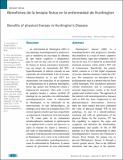Mostrar el registro sencillo del ítem
Beneficios de la terapia física en la enfermedad de Huntington
| dc.creator | Suárez Rojas, José David | |
| dc.creator | Vásquez Cerdas, Melissa | |
| dc.date.accessioned | 2018-10-18T16:54:15Z | |
| dc.date.available | 2018-10-18T16:54:15Z | |
| dc.date.issued | 2015 | |
| dc.identifier.citation | http://accn.cr/index.php/quienes-somos/20-frontpage/297-neuroeje | |
| dc.identifier.issn | 1011-5684 | |
| dc.identifier.uri | https://hdl.handle.net/10669/76023 | |
| dc.description.abstract | La enfermedad de Huntington (EH) es una patología neurodegenerativa progresiva, que se manifesta en una triada de síntomas de tipo motor, cognitivo y psiquiátrico, para la cual no hay cura en la actualidad. Se hereda de forma autosómica dominante, con un riesgo de transmisión del 50%. Específcamente, el defecto consiste en una expansión del trinucleótido CAG (CitosinaAdenina-Guanina) en el gen HTT. Las expansiones son traducidas en un segmento de poliglutamina en la proteína huntingtina, hecho que genera una disfunción celular y degeneración neuronal, sobre todo a nivel de ganglios basales y corteza cerebral. El abordaje de los pacientes con enfermedades neurodegenerativas como la enfermedad de Huntington, se ha enfatizado en las intervenciones de tipo farmacológico, sin embargo, en el marco de la terapia física (TF) existen algunos estudios que han comprobado su importancia y benefcios en la enfermedad. La TF, como parte de un tratamiento interdisciplinario, mediante la optimización de la aptitud física a través del ejercicio, es capaz de mejorar los signos y síntomas y por ende la funcionalidad, independencia y calidad de vida del paciente con la enfermedad de Huntington, tal y como se ha evidenciado en otras enfermedades neurodegenerativas, como la enfermedad de Parkinson. La única manera de prevención de esta enfermedad es a través de un correcto asesoramiento genético. Debido a las diversas alteraciones que se manifestan en los pacientes con EH, la TF podría tener la capacidad de realizar una contribución importante en la atención de esta enfermedad. | es_ES |
| dc.description.abstract | Huntington’s disease (HD) is a neurodegenerative and progressive disorder that manifests in a triad of motor, cognitive and psychiatric signs and symptoms, and it has yet no cure. It is caused by an autosomal dominant mutation, which yields a 50% risk of transmission. Specifcally, the genetic defect consists in a CAG triplet expansion (Cytosine-Adenine-Guanine) within the HTT gen. The expansions are translated into a polyglutamine tract in a protein that has been called huntingtin. This mechanism generates cellular dysfunction and in consequence neuronal degeneration, mainly at the basal ganglia and cerebral cortex. The approach of the patients with neurodegenerative diseases such as HD has been emphasized in the pharmacological interventions; however there are some studies that have confrmed the value of physical therapy (PT) in this pathology. As part of a interdisciplinary treatment and with an optimization of the physical ftness by the exercise, PT has the capability to improve the signs and symptoms and therefore the functionality, independence and quality of life of HD patients, as it has been demonstrate in other neurodegenerative diseases like Parkinson’s disease. Even though, the unique way to prevent Huntington’s disease is through a correct genetic advice. Due to the different alterations that take place in the patients, PT could have the capability to make an important contribution in the treatment of this condition. | es_ES |
| dc.language.iso | es | es_ES |
| dc.rights | Attribution-NonCommercial-NoDerivatives 4.0 Internacional | * |
| dc.rights.uri | http://creativecommons.org/licenses/by-nc-nd/4.0/ | * |
| dc.source | Revista Neuroeje, vol. 28(1), pp. 24-36 | es_ES |
| dc.subject | Enfermedad de Huntington | es_ES |
| dc.subject | Enfermedades neurodegenerativas | es_ES |
| dc.subject | Terapia física | es_ES |
| dc.subject | Ejercicio | es_ES |
| dc.subject | Rehabilitación | es_ES |
| dc.subject | Huntington’s disease | es_ES |
| dc.subject | Neurodegenerative diseases | es_ES |
| dc.subject | Physical therapy | es_ES |
| dc.subject | Exercise | es_ES |
| dc.subject | Rehabilitation | es_ES |
| dc.subject | 615.82 Terapias físicas | es_ES |
| dc.title | Beneficios de la terapia física en la enfermedad de Huntington | es_ES |
| dc.title.alternative | Benefts of physical therapy in Huntington’s Disease | es_ES |
| dc.type | artículo original | |
| dc.description.procedence | UCR::Vicerrectoría de Investigación::Unidades de Investigación::Ciencias de la Salud::Instituto de Investigaciones en Salud (INISA) | es_ES |
| dc.description.procedence | UCR::Vicerrectoría de Investigación::Unidades de Investigación::Ciencias de la Salud::Centro de Investigación en Neurociencias (CIN) | es_ES |



